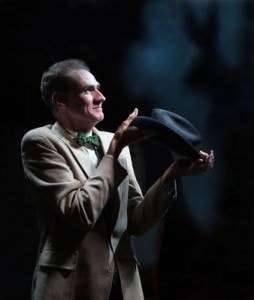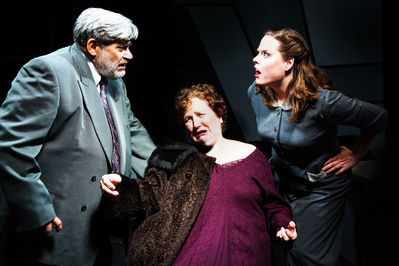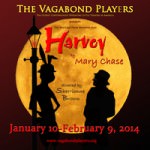People are people no matter where you go. Unless they’re not people, in which case they might be a giant white rabbit measuring in at six feet eight inches— I’m sorry, six feet eight and a half inches— they might just be a Pooka. What’s a Pooka? Look it up! Or head down to The Vagabond Players to see Mary Chase’s Harvey, both are good options, but it’ll be much more fun if you go to the theatre rather than brush off the dictionary. Directed by Sherrionne Brown, this touching, albeit unusual, comedy, combines heartwarming kindness with a whopping dose of hilarity. Insanity doesn’t run throughout this play, it gallops and what better way to enjoy those laughable moments of life’s lunacy than with an enormous bunny rabbit at your side?

Director Sherrionne Brown, serving as the show’s Co-Set Designer and Costume Designer produces a brilliant vision upon the Vagabond Players’ stage; a lively capsule of vivid imagery painted into both the scenic work and the outfits for the actors that encompasses the 1940’s era. Brown crafts the epitome of “page to stage” in her costume work, particularly with Myrtle Mae’s opening scene dress— complete with ruffles and a bow down the back. Brown’s eccentric dresses for Veta and Aunt Ethel are subtle reflections of the colorful mental state of the show, while her pristine and crisp white nurse’s uniform for the sanitarium augments the time period of the production.
Co-Set Designer Roy Hammond, working closely with Brown, produces a stunning set that marvels the mind with its complexity. A well furnished, cozy library of the Dowd estate transforms into an enormous intake room at the Chumley Rest Sanitarium. The juxtaposition of the enclosed, intimate library— draped in a warming but familiar shadow of dark woods and dusty tomes— and the sprawling bright blue Sanitarium showcases Hammond and Brown’s versatile imaginations when it comes to creating atmospheric ambiance.
Brown’s directorial approach to the show infuses mythical magic into reality, each scene living in the moment of which it was conceived. The cast unifies as one unit that tells a story, each character a refreshing splash of vivacious paint on an otherwise blank canvas. The cohesive bond between the performers translates into a well-oiled production where moments are lived for truth and stir the soul of humanity while drawing forth peels of good-natured laughter. Brown constructs a universe on the stage, letting the story of Harvey come to life like any good story; well articulate, expressed with an exciting enthusiasm and all around spun in a most appeasing fashion.
It’s the little characters that make the story pop. Three in particular pop straight out of the sanitarium: Nurse Kelly (Amy McQuin), the orderly Wilson (Colin Holmes) and Dr. Sanderson (Chris Cotterman). The trio crafts moments of sheer hilarity, using mostly their wildly expressive facial features. All three performers have adapted the behavioral senses of the medical staff from the 1940’s— between their tone of voice, the way in which they articulate certain phrases, and their physical approach— the trio feels like they’ve walked straight out of 1944 and onto the stage. McQuin is a feisty performer who lets her sweet naiveté shine through in moments where she’s complimented by Elwood P. Dowd, but otherwise holds her own in the sanitarium filled with opinionated men. Cotterman has a rigid posture that adds humor to his spastic outbursts when situations run amuck. But it’s Holmes who is crowned king of this funny bunch; his bombastic outbursts and overall brusque manner applied to every situation in which he finds himself is a testament to how thoroughly he has developed the character, much more deeply than just the initial creation of ‘loose cannon.’
Of course the insanity, or questionable neurological behavior, does not rest solely on those found at the sanitarium. Veta Louise (Joan Crooks) and her daughter Myrtle Mae (Karina Ferry) are quite the expressive duo when it comes to frustrations, hallucinations, and emotional grievances. Ferry is wildly childish when it comes to throwing her tantrums over her uncle Elwood and her facial expressions reflect that unruly tantrum style behavior, particularly when she’s not getting her way. Ferry’s approach to hysterics mimics that of Crooks’, creating the illusion that they are truly a mother and daughter team. Crooks, as the dynamic Veta Louise, finds the delicate balance of matriarchal madness against sympathetic sisterhood. Shifting quickly from extremes of biting ferocity to simpering sorrow, Crooks masters the emotional fluctuations in Veta’s character with a seasoned hand. Crafting a sturdy stage presence she creates depth in Veta, allowing us to see her brash and honest side as well as her vulnerable and caring side.

The performance given by Phil Gallagher as Dr. Chumley is nothing short of astonishing. Stepping into the role with just three rehearsals and three days before the show opened, Gallagher amazes the audience with his portrayal of the big shot psychiatrist who later loses his mind. Gallagher has a commanding stage presence that draws your eye before he even speaks, and his ability to create distinctive strokes between the well composed version of his character and the mentally compromised edition are impressive. His eyes are particularly reactionary and his spastic fashion of handling Elwood in the later scenes of Act II are nothing short of comic brilliance.
We come at last to the focus of all the commotion, Mr. Elwood P Dowd (Roy Hammond.) An exceptionally stellar performance given by Hammond stirs the production to completion. Hammond finds the vulnerable humanity inside of Dowd while still giving him that questionable flare and unsettlingly, albeit colorful, edge of mental ambiguity. There is something truly striking about his performance, tugging at your heartstrings in the final act when you sympathize for him because of his kind heart and honest devotion to his character’s sister. Aside from a sensationally present state of being upon the stage Hammond crafts Harvey to life with an elegant ease, really encouraging the audience to believe in Harvey. A remarkable performance from a talented man that insinuates himself flawlessly in a well working cast for a fantastic production.
Don’t live among the flyspecks. Find the miracles that are leaning on the lampposts; find your Pooka at The Vagabond Theatre before Harvey disappears.
Running Time: Approximately Two hours and 50 minutes, with one intermission.
Harvey plays through February 9, 2014 at The Vagabond Players— 806 South Broadway in Baltimore, Maryland. For tickets, call the box office at (410) 563-9135, or purchase them online.






Great job Colin. Nanny & grandpa.